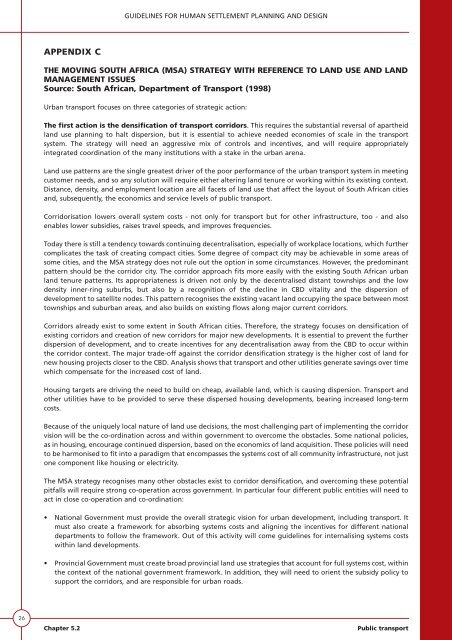VOLUME 1 HUMAN SETTLEMENT PLANNING AND ... - CSIR
VOLUME 1 HUMAN SETTLEMENT PLANNING AND ... - CSIR
VOLUME 1 HUMAN SETTLEMENT PLANNING AND ... - CSIR
- No tags were found...
Create successful ePaper yourself
Turn your PDF publications into a flip-book with our unique Google optimized e-Paper software.
GUIDELINES FOR <strong>HUMAN</strong> <strong>SETTLEMENT</strong> <strong>PLANNING</strong> <strong>AND</strong> DESIGNAPPENDIX CTHE MOVING SOUTH AFRICA (MSA) STRATEGY WITH REFERENCE TO L<strong>AND</strong> USE <strong>AND</strong> L<strong>AND</strong>MANAGEMENT ISSUESSource: South African, Department of Transport (1998)Urban transport focuses on three categories of strategic action:The first action is the densification of transport corridors. This requires the substantial reversal of apartheidland use planning to halt dispersion, but it is essential to achieve needed economies of scale in the transportsystem. The strategy will need an aggressive mix of controls and incentives, and will require appropriatelyintegrated coordination of the many institutions with a stake in the urban arena.Land use patterns are the single greatest driver of the poor performance of the urban transport system in meetingcustomer needs, and so any solution will require either altering land tenure or working within its existing context.Distance, density, and employment location are all facets of land use that affect the layout of South African citiesand, subsequently, the economics and service levels of public transport.Corridorisation lowers overall system costs - not only for transport but for other infrastructure, too - and alsoenables lower subsidies, raises travel speeds, and improves frequencies.Today there is still a tendency towards continuing decentralisation, especially of workplace locations, which furthercomplicates the task of creating compact cities. Some degree of compact city may be achievable in some areas ofsome cities, and the MSA strategy does not rule out the option in some circumstances. However, the predominantpattern should be the corridor city. The corridor approach fits more easily with the existing South African urbanland tenure patterns. Its appropriateness is driven not only by the decentralised distant townships and the lowdensity inner-ring suburbs, but also by a recognition of the decline in CBD vitality and the dispersion ofdevelopment to satellite nodes. This pattern recognises the existing vacant land occupying the space between mosttownships and suburban areas, and also builds on existing flows along major current corridors.Corridors already exist to some extent in South African cities. Therefore, the strategy focuses on densification ofexisting corridors and creation of new corridors for major new developments. It is essential to prevent the furtherdispersion of development, and to create incentives for any decentralisation away from the CBD to occur withinthe corridor context. The major trade-off against the corridor densification strategy is the higher cost of land fornew housing projects closer to the CBD. Analysis shows that transport and other utilities generate savings over timewhich compensate for the increased cost of land.Housing targets are driving the need to build on cheap, available land, which is causing dispersion. Transport andother utilities have to be provided to serve these dispersed housing developments, bearing increased long-termcosts.Because of the uniquely local nature of land use decisions, the most challenging part of implementing the corridorvision will be the co-ordination across and within government to overcome the obstacles. Some national policies,as in housing, encourage continued dispersion, based on the economics of land acquisition. These policies will needto be harmonised to fit into a paradigm that encompasses the systems cost of all community infrastructure, not justone component like housing or electricity.The MSA strategy recognises many other obstacles exist to corridor densification, and overcoming these potentialpitfalls will require strong co-operation across government. In particular four different public entities will need toact in close co-operation and co-ordination:• National Government must provide the overall strategic vision for urban development, including transport. Itmust also create a framework for absorbing systems costs and aligning the incentives for different nationaldepartments to follow the framework. Out of this activity will come guidelines for internalising systems costswithin land developments.• Provincial Government must create broad provincial land use strategies that account for full systems cost, withinthe context of the national government framework. In addition, they will need to orient the subsidy policy tosupport the corridors, and are responsible for urban roads.26Chapter 5.2Public transport
















